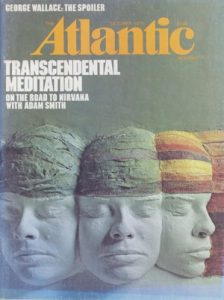Jennie Rothenberg Gritz, writing for The Atlantic, says that when she was a child, her parents enrolled her “in a small private school where the day began and ended with TM.” That was back in the 80s. Today, it seems that the David Lynch FoundationSM can’t keep up with the demand for the Transcendental Meditation® (TM®)technique and the Quiet Time program in schools across the country. In her article, Ms. Gritz takes us into some of their classrooms.
 Many of the schools that have introduced the program are located in low-income neighborhoods where the kids experience a great deal of stress. One principal reported that “his students rush to and from school to avoid getting jumped or shot… This wear and tear increases the risk of stress-related physical and mental illness later in life.”
Many of the schools that have introduced the program are located in low-income neighborhoods where the kids experience a great deal of stress. One principal reported that “his students rush to and from school to avoid getting jumped or shot… This wear and tear increases the risk of stress-related physical and mental illness later in life.”
Gritz’s first stop was at Visitacion Valley Middle School in San Francisco. “This is a neighborhood that’s had a lot of murders,” said Jim Dierke, the former Visitacion Valley principal. “A lot of death, a lot of incarceration, and a lot of poverty and unhappiness.” He decided to try TM to improve the kids’ ability “to cope with the violence and tensions around them.”
How Does Quiet Time Work?
Gritz explains: “In public schools, TM is offered through a program called Quiet Time. The meditation itself isn’t mandatory: When kids don’t want to meditate, or their parents won’t sign their permission forms, they can just sit quietly, reading a book or staring out the window. In Northern California, Quiet Time is run by a local nonprofit called the Center for Wellness and Achievement in Education, which licenses the TM technique from a central organization and covers the cost of the program.”
Principal Dierke says, “It’s been a very good partnership, assisting all of us in dealing with stress—not only the kids but the adults. My blood pressure got lower. I became less prone to yelling at people. And I see it in the kids. Meditation is kind of like the glue that holds everything together.” On a recent California Health Kids Survey, reports Gritz, “Visitacion Valley scored higher for happiness than any other school in San Francisco, including much more affluent ones.”
Other Significant Results
Later, other changes were noted by researchers: “In the first year of Quiet Time, the number of suspensions fell by 45 percent. Within four years, the suspension rate was among the lowest in the city. Daily attendance rates climbed to 98 percent, well above the citywide average. Grade point averages improved markedly.”
Bill Kappenhagen, the principal of Phillip and Sala Burton Academic High School, was hesitant to introduce the program at first, but after its implementation, he reported, “It’s a calmer school. And it’s not like I have more deans or security guards or teachers. It’s the same staffing structure. The school community has been given space to decompress.”
“At some point, I realized I had so much more energy than I used to. I felt happier, a lot happier. I had way more self-confidence.” —Quiet Time student, Burton High School
A similar story emerged with each new school Gritz visited, including responses from the students, teachers, administrators, and paid program managers about the program’s results.
 One Burton graduate said, “Honestly, it just became a normal routine. And when you do normal routines, it doesn’t feel like you’re having some kind of change within yourself. But at some point, I realized I had so much more energy than I used to. I felt happier, a lot happier. I had way more self-confidence. And I used to be somebody who holds grudges: ‘If you messed up, you messed up!’ Suddenly I was like, ‘You know what? It’s okay.’ And if I messed up personally, I wasn’t down on myself for the entire day. I was like, ‘Okay, I messed up on this one thing, but I’m going to be fine now.’ ”
One Burton graduate said, “Honestly, it just became a normal routine. And when you do normal routines, it doesn’t feel like you’re having some kind of change within yourself. But at some point, I realized I had so much more energy than I used to. I felt happier, a lot happier. I had way more self-confidence. And I used to be somebody who holds grudges: ‘If you messed up, you messed up!’ Suddenly I was like, ‘You know what? It’s okay.’ And if I messed up personally, I wasn’t down on myself for the entire day. I was like, ‘Okay, I messed up on this one thing, but I’m going to be fine now.’ ”
More Resources Needed
Having proven its effectiveness, and with a growing waiting list of schools wanting to implement the program, the only hurdle facing expansion of the program is insufficient resources.
Read the full Atlantic article ►


Comments
YOU MAY ALSO LIKE
TM in the News
Meditation Curbs Violence at San Francisco Schools | 3:11
What happens when the TM technique is added to the curriculum of a struggling school? NBC Nightly News and Cynthia McFadden wanted to find out.
Science & Research
New Study Shows Quiet Time Develops Resilience in Urban Youth
A WestEd study in Contemporary School Psychology matched 141 freshmen participating in the school's Quiet Time program with students at a similar school.
TM in the News
HuffPost Reports: TM Comes to Brooklyn School
In case you haven't heard, Transcendental Meditation is on the minds of many students, teachers, and administrators. Jaweed Kaleem took an in-depth look.
Education
Transforming the Way Children Learn: How to Save the Coming Generation | 2:52
“In today’s world of fear and uncertainty, every child should have two periods a day to dive deep within themselves and experience the field of silence and inner happiness.” —David Lynch